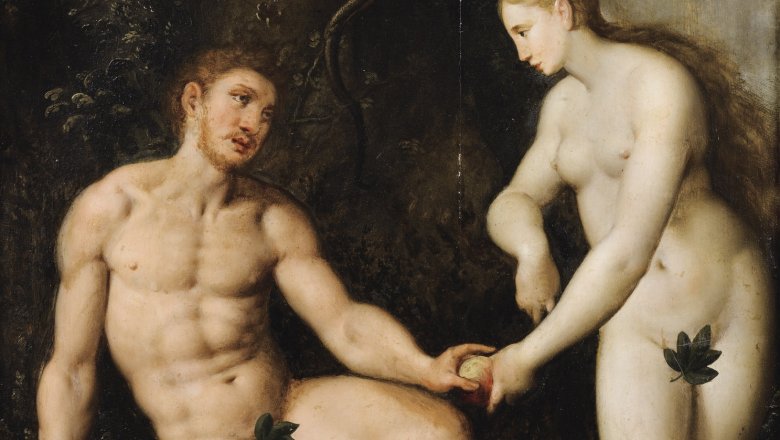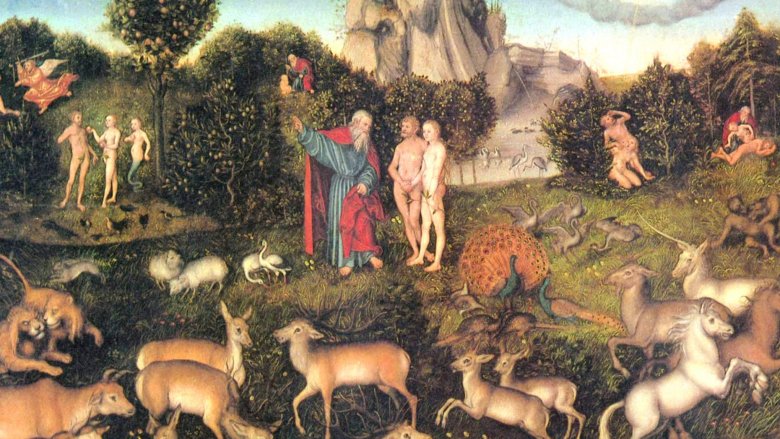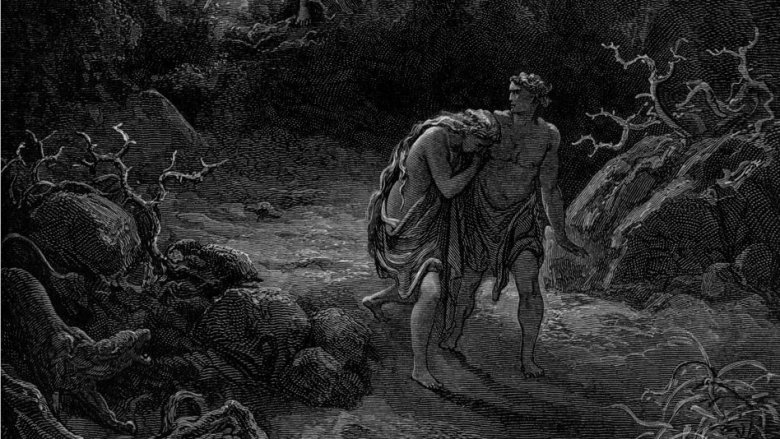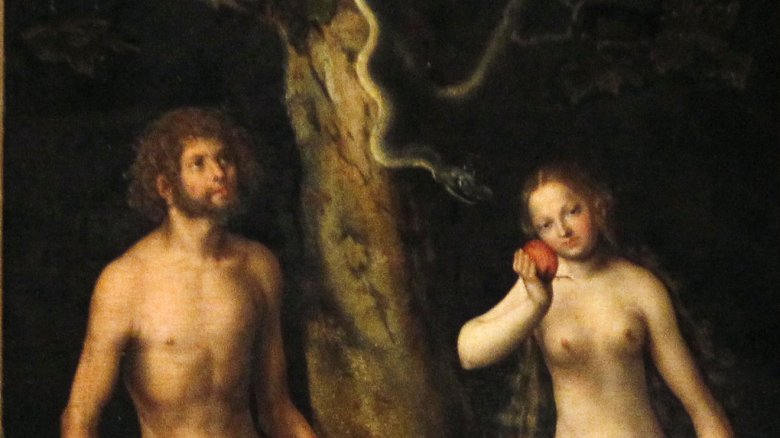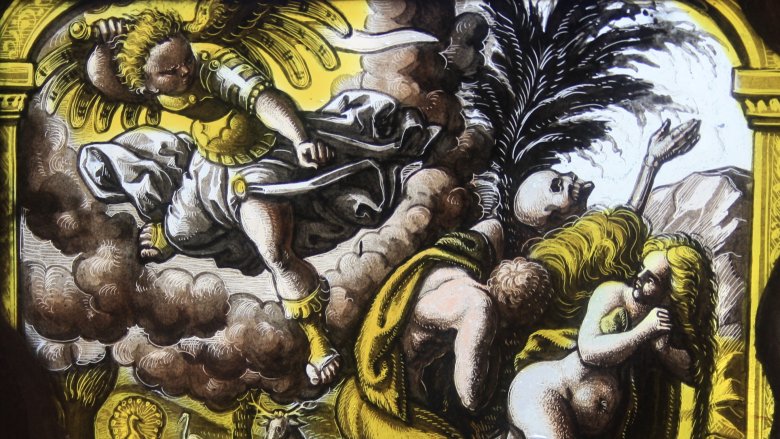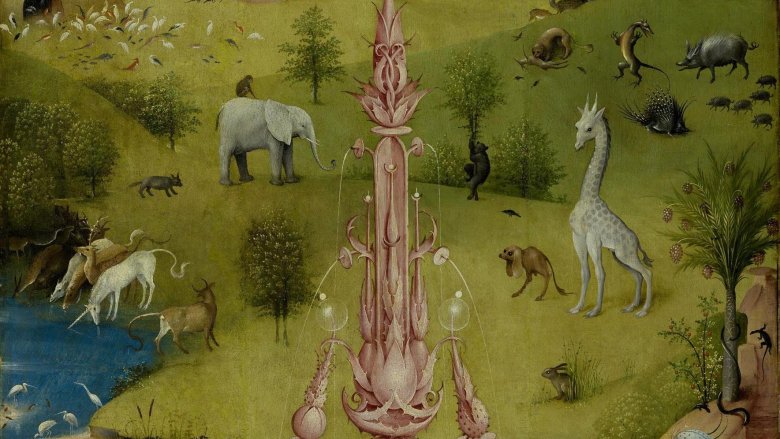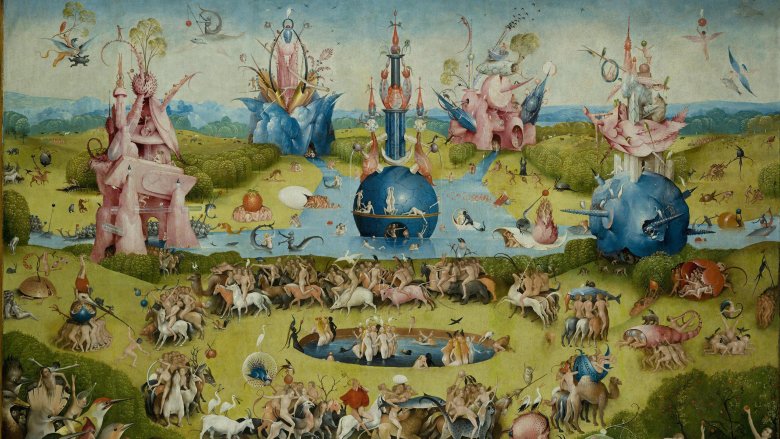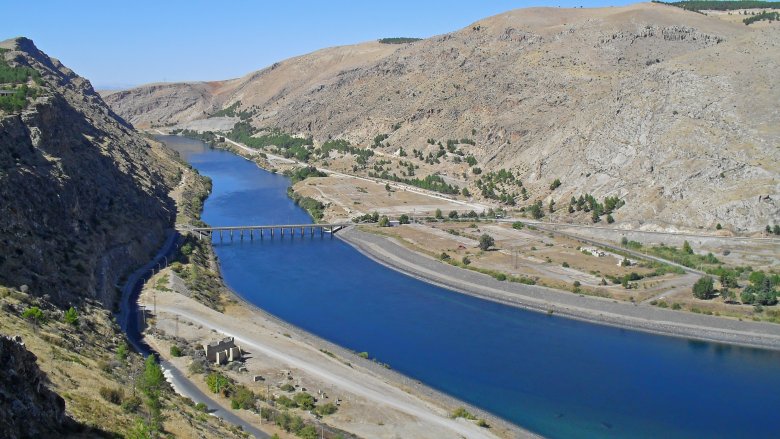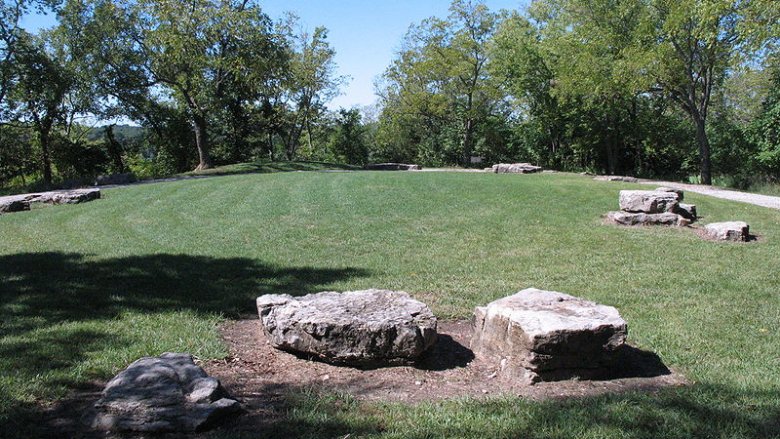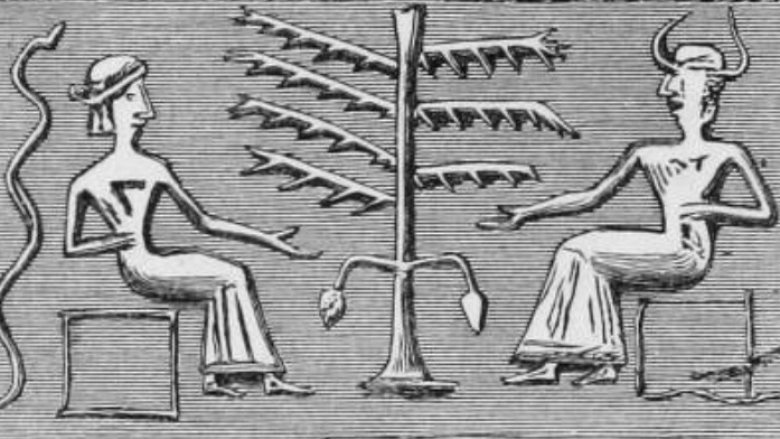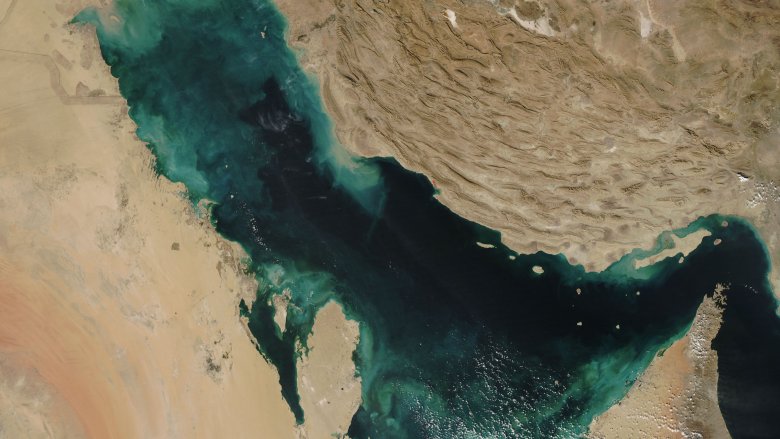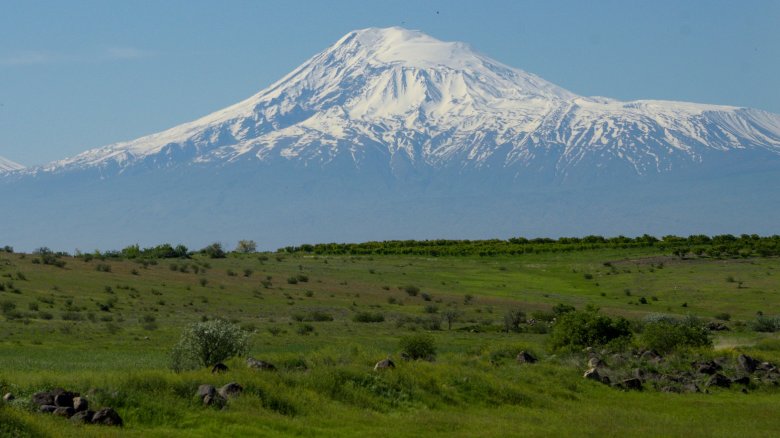The Untold Truth Of The Garden Of Eden
The Garden of Eden, the terrestrial Paradise known also as the Garden of God, is one of the most famous settings in the Bible. It is a special, peaceful garden oasis God created as a home for Adam and Eve (and maybe also Lilith) where their two jobs were to give animals names and not eat one specific fruit. The first job went great, as attested to by the existence of animal names such as the blue-footed booby, the titmouse, and the dik-dik, but the second one wasn't exactly a rousing success. After making the first mistake in history, the two were driven out of the Garden, never to return (probably).
Despite the fact only two humans have allegedly ever been there, the idea of a paradise on Earth has captured the interest of generations of people who presumably don't like to be told what fruit they can and can't eat and who probably scoff at "no trespassing" signs. If you're the kind of person eager to know about the place where humanity lost their innocence and snakes lost their legs, read on!
The Garden of Eden in the Book of Genesis
The main appearance of the Garden of Eden in the canonical Bible is, of course, in the book of Genesis, during the second account of creation that begins in chapter 2. Verse 8 says, "And the Lord God planted a garden in Eden, in the east; and there he put the man whom he had formed." The origin of the word "Eden" is unknown, but the Jewish Encyclopedia suggests it was a loanword from Assyrian meaning "field" or "plain," while Strong's Hebrew Lexicon asserts it is related to a Hebrew word meaning "pleasure."
If you know of the Garden of Eden at all, you probably know the Genesis narrative: Eden was the place where God made a home for the first man (and eventually woman), filled with all sorts of plants and animals, including the famous Tree of Life and Tree of the Knowledge of Good and Evil, the latter of which Adam and Eve were instructed not to eat from. They do, of course, and God kicks them out of the Garden, leaving behind angels to keep the now sinful humans from having access to the Tree of Life and living forever as corrupted beings. Adam and Eve subsequently invent the idea of working for a living and raise children who will invent the concept of murder.
The Garden of Eden in the Book of Ezekiel
Although no one in the canonical Bible ever makes a visit to Eden after Adam and Eve's expulsion therefrom, there are a few notable references to the Garden scattered throughout the prophecies in the Book of Ezekiel. For example, in chapter 31, God's message through Ezekiel compares the powerful Egyptian pharaoh to a mighty cedar tree, greater in "glory and greatness" than the trees in Eden (which sounds like a compliment, but ultimately the message is God doesn't care how cool a tree is; he'll cut it down when he feels like it).
Probably the best known Eden-related passage in Ezekiel, however, comes in the middle of chapter 28, wherein God makes his proclamation against the wicked king of Tyre. In an extended metaphor, God compares this king to an angel in the Garden who had been bedecked with all manner of jewels and gold. Eventually sin creeps in in the form of vanity and violence, and God has the angel expelled and thrown into fire and ashes. While this scenario is meant to describe the fall from grace of a human king — probably Ithobaal III, who lived at the same time as Ezekiel — some Christians consider this passage to be a description of the fall of Satan as a beautiful, beloved angel cast into fire for his pride, corrupted wisdom, and violence.
The serpent in the Garden of Eden wasn't Satan
The most famous incident in the Garden of Eden comes in the third chapter of Genesis, in which the serpent — "more crafty than any other wild animal that the Lord God had made" — appears to Eve and convinces her to eat of the Tree of Knowledge, the one thing God had forbidden the first humans to do. As you know, she not only ate the fruit, but also shared it with Adam, bringing about the Fall of Man and leading to their expulsion from the Garden. This, then, according to the biblical Creation story, is why — in short — life sucks and then you die. From a modern perspective and in popular interpretation, it has been common to explain the serpent who tempts humanity to sin is the Devil in disguise. In fact, for Christians, God's promise to the serpent Eve's offspring would crush him is a way of foretelling Jesus's ultimate victory over Satan in the End Times.
The thing is, though, the Eden serpent was not meant to be Satan. How do we know? Well, as Biblical Archaeology puts it, when the book of Genesis was composed, the idea of the Devil hadn't been invented yet. The idea of a powerful supernatural force who opposes God didn't develop until the first and second centuries BCE. Sometimes — as with St. Patrick – a snake is just a snake because people hate snakes.
The Garden of Eden is guarded by terrifying angel monsters
According to Genesis 3:24, when God drove Adam and Eve out of Eden, he placed cherubim and a spinning, flaming sword at the east entrance to keep humans from ever entering the Garden again. A flaming sword is pretty easy to picture, but what are cherubim? Nowadays we tend to think of cherubs as chubby angel babies thanks to their having been conflated with Cupids and putti from Roman mythology and Italian art. The cherubim in the Bible are, uh, somewhat different.
As the Jewish Encyclopedia explains, cherubim are explained in Ezekiel as being mashups of humans, oxen, eagles, and lions, who hold up God's throne and move unflinchingly forward, like unturning chariot wheels. This likely relates to the statues of cherubim on the mercy seat, which was the cover of the Ark of the Covenant where God himself was known to sit. The post-biblical literature of rabbis expounds the cherubim at the entrance to Eden were created on the third day of Creation and had no definite shape or gender, but were fully fluid in their appearance. The Encyclopedia goes on to argue the idea of enormous beings of great power without human emotion as representatives of gods and protectors of holy spaces is an ancient Semitic belief that can also be found in the winged bulls and lions at Babylonian and Assyrian temple entrances.
There are actually two Gardens of Eden
As the Jewish Encyclopedia explains, for the scholars behind the Jewish theological writings known as the Talmud and the esoteric school of Jewish mysticism known as Kabbalah, there is not one, but two Gardens of Eden. One of these is the earthly Garden where Adam and Eve lived and ate fruit and played with penguins or whatever, and the other is a celestial paradise where the immortal souls of the righteous live. These two concepts are distinguished by referring to a "lower" and "higher" Garden of Eden, or calling the earthly location Gan ("garden") and the heavenly one Eden.
In the 19th century collection of Jewish folk belief called The Legends of the Jews, author Louis Ginzberg relates the higher Eden is connected to Paradise and is where God hangs out and explains Torah to people. It's made up of 310 worlds divided into seven different compartments for various classes of pious people. In chapter 2, Ginzberg explains the Tree of Life is so huge it would take you 500 years to walk the length of the diameter of its trunk. While in the Garden, angels brought Adam and Eve meat and wine and all the animals could talk people language. When a person dies, their soul passes through lower Eden to reach higher Eden, but if they were unrighteous, the guardian cherub annihilates their soul with the flaming sword.
The terrestrial Garden and the celestial Eden
If you're not Jewish, it would be pretty easy to assume Jewish people hold a similar view of the afterlife that Christians do (or at least, the popular understanding of what Christians believe): the righteous go to Heaven, and the unrighteous go to Hell. But while some strains of Jewish belief incorporate separate fates for the holy and the wicked, Jewish eschatology (that is, theology of the End Times and the afterlife) is focused more on the resurrection of the dead in a bodily form following an era of justice and peace led by a literal or metaphorical messiah, leading to the creation of a new Heaven and Earth and history closing the loop on itself by having humankind return to — you guessed it — the Garden of Eden.
As the Jewish Encyclopedia explains, various apocalyptic writings describe Eden as a place for the "righteous who suffer innocently, who do works of benevolence and walk without blame before God" and which will "appear suddenly at the Judgment Day in all its glory." Those who make it to the celestial Eden will wear clothes made of light and enjoy the immortality that comes from eating of the Tree of Life. The wicked will suffer sevenfold punishment, while the righteous will enjoy sevenfold happiness, living in mansions and walking with God, who leads them in dance (presumably the Cha-Cha Slide).
The four rivers of the Garden of Eden
A question that has been asked and debated for centuries is the location of the Garden of Eden. And, to be fair, if you knew there was a place with talking animals, a flaming sword, and a tree that could let you live forever, you'd want to at least grab an Instagram selfie there. Naturally, the biblical account is the starting place for most people who assume the Garden was more than a metaphor. Genesis chapter 2 says Eden had a river flowing out of it that spread into four branches which formed the Pishon, Gihon, Chidekel, and Phirat rivers. The latter two are identified as the Tigris and Euphrates, which you may remember from eighth grade social studies, but the other two have been a little harder to pin down.
The Jewish Encyclopedia explains the traditional identifications of the other two rivers. Genesis says the Pishon flows around a land called Havilah, which is identified with India, thus making that river either the Indus River or — as the Jewish historian Josephus identifies it — the Ganges. Gihon is said to flow around the land of Cush, which is usually identified with Ethiopia, making the Gihon the famous Nile River. That these rivers don't actually, you know, touch has been explained by the idea topography was radically changed by the advent of Noah's flood.
The Garden of Eden in the Show-Me State
From the information provided in Genesis and other sacred texts, it would be pretty easy to assume Eden is located somewhere in the Middle East — at least within spitting distance of the Tigris and Euphrates — or else is located on a more celestial plane accessible only by righteous souls after Judgment Day. For Mormons, however, the terrestrial paradise is a little closer to home.
As Fair Mormon explains, Latter Day Saints tradition teaches the Garden of Eden was located somewhere in Jackson County, Missouri. Specifically, LDS doctrine teaches after being driven out of Eden, Adam and Eve settled in a land known as Adam-ondi-Ahman, which is located in modern day Daviess County, Missouri. Joseph Smith is said to have received a divine revelation upon witnessing a rock formation that resembled an altar that this place was where Adam blessed his descendants and made offerings to God. Perhaps more pressingly, it is to this location Jesus will return and build a New Jerusalem in fulfillment of prophecy. Fair Mormon concedes it is possible the divine revelation might have marked the Missouri site as key to this future event which reflects another, non-Missouri location from Adam's mortal past (which would explain the doctrine's references to mountains in Adam-ondi-Ahman, which would be unusual in notoriously flat Missouri), though this is not the common interpretation.
Possible inspirations for the Garden of Eden
While the story of Adam and Eve in the Garden of Eden is a foundational story for Judaism, Christianity, and Islam, the idea of a garden of heavenly delights bears some similarities to elements from non-Abrahamic religions. This isn't that unusual; a number of early Jewish stories resemble other Near Eastern legends, such as Noah's flood echoing the story of Utnapishtim in the Epic of Gilgamesh and baby Moses's basket of bulrushes copying off the paper of the legendary account of the birth of Sargon of Akkad (the Mesopotamian king, not the internet racist).
While the Garden of Eden bears some cosmetic similarities to the Garden of the Hesperides from Greek myth — an idyllic horticultural setting including apples of some significance attended by a notable serpent — it is in Near Eastern myth that one will find striking similarities. The Jewish Encyclopedia notes how Gilgamesh's Utnapishtim lived in a place described — like Eden — as a confluence of streams, as well as relating the Garden's serpent to a snake from a Babylonian creation story. Perhaps even more significantly, the Sumerian city of Dilmun was a fertile oasis believed to be the residence of deities including Enki, the god of wisdom, where sweet water flowed and no one ever got sick or grew old. Some myths name Dilmun as the site of creation and the final home of the immortalized Utnapishtim, leading some to believe it was an inspiration for Eden.
Is the Garden of Eden underwater?
While a large number of scholars understand the story of the Garden of Eden to be mythological or at least metaphorical, there have nevertheless been some relatively serious archaeological inquiries into the location of paradise on Earth. According to an article from Smithsonian magazine in 1987, one such investigation posits the story of Eden was metaphorical, just not that metaphorical. While scholars of mythology would argue the story of the Garden of Eden — as well as similar concepts such as the Golden Age in Greco-Roman mythology — represent a shared memory of a time when everything was provided for us without effort (i.e., childhood), archaeologist Juris Zarins argued the story of Adam and Eve's expulsion from the Garden was a metaphor for society's transition from hunting and gathering to agriculture. Also: the Garden is underwater.
Using the logical starting point of the Tigris and Euphrates and positing that when the Bible says Eden was "in the east" it means east of Israel, Dr. Zarins used satellite imagery to argue the Pison is a now-dry river in northern Arabia and the Gihon is the Karun River, which flows from Iran into the Persian Gulf. This would place the Garden at the head of the Gulf and currently under its waters, so bring a snorkel if you want to go hunting for the Tree of Life.
Is the Garden of Eden in Armenia?
One of the oft proposed locations for the Garden of Eden is in the nation of Armenia, again starting with the Tigris and Euphrates, whose headwaters are found in Armenia. Further association comes from the presence of Mount Ararat on the Armenian Plateau. Mount Ararat is the site traditionally identified as the landing place of Noah's ark, so the idea is humankind's post-diluvian rebirth would be near its original place of birth.
The Armenian history and culture site People of Ar collects accounts of prominent and notable people who have argued for Armenia as the location of the Earthly paradise, often contrasting the peaceful ideal of Eden with the grim reality of Armenia's often violent history. Proponents of an Armenian Eden include the Romantic poet Lord Byron, who mourned "the satraps of Persia and the pachas of Turkey have alike desolated the region where God created man in his own image." Likewise, the Encyclopedia of Biblical, Theological, and Ecclesiastical Literature names Armenia as the most likely of nine possible candidates for the location of the Garden, going so far as to narrow down specific lines of latitude between which Eden must have lain. And to be fair, if Armenia can produce Alvin and the Chipmunks creator Ross "Dave Seville" Bagdasarian, truly it is a land of wonders, so who can say?
